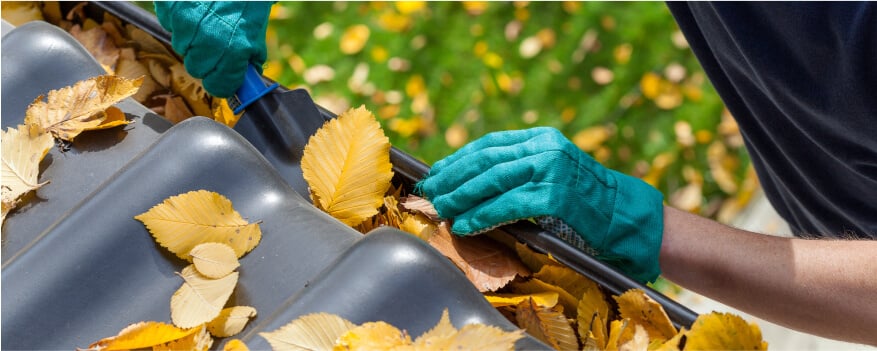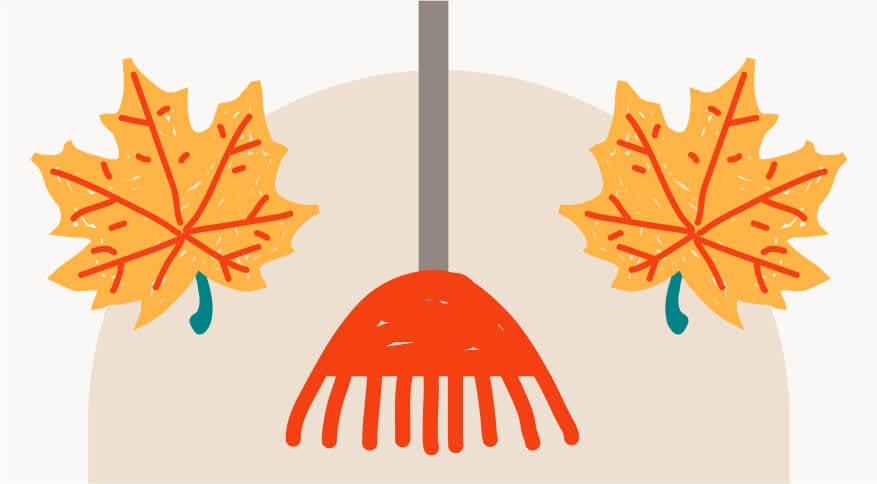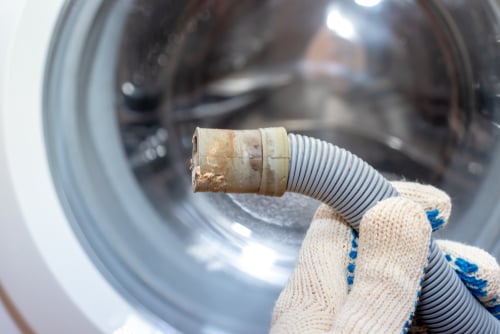As the days grow shorter and the leaves turn brown, it’s time to shift focus to fall maintenance. There’s a lot to do to prepare your home for the winter months, and fall is a great time to make use of cooler temperatures for essential outdoor upkeep.
From preparing your lawn and trees for the first frost, to guaranteeing that your garden beds thrive when spring arrives, our Experts have assembled a list of the most important items on your fall lawn care checklist. Enjoy this exhaustive guide to how to care for your lawn in the fall.
End-of-summer lawn care
Tree and shrub care
Garden bed maintenance
Winterizing equipment and tools
Gutter cleaning
Outdoor furniture
Final fall cleanup
End-of-summer lawn care

Summer can take a toll on lawns — scorching temperatures, relentless sun, and outdoor gatherings can leave your lawn looking yellow, patchy, and worn out. Take advantage of the fall growing season to repair the summer wear-and-tear and prepare your lawn for winter with these fall lawn treatment tips.
-
1
Aerating
If your grass seems stressed, hard to the touch, or is suddenly bad at absorbing rainwater, it might be time to aerate. Along with other basic fall lawn care practices, aeration is key to helping nutrients reach the soil below your grass. The best time to aerate is during the growing season—late summer if you're in the Northern U.S., or late spring for those in the Southern U.S.
Choose the day after rainfall for best results. Use an aeration machine to remove plugs of soil from your yard. Concentrate the machine on areas of the lawn that you think have experienced the most compaction, like the site of your last garden party.
-
2
Overseeding
Just like with aeration, the perfect time to overseed your grass is when the grass is in its growing season. If your lawn seems bare and patchy, spruce up some thin areas and improve the overall health of your lawn by introducing new seeds through a fall grass treatment. By spreading grass in the late summer, you’ll give the seedlings time to take root before the winter frost. Plus, if you’ve aerated first, those little pockets in the soil are perfect places for your grass seeds to take root.
-
3
Fertilizing
Fertilizing your lawn is another great way to help fill in some of the singed and scrubby patches from the summer. Applying a slow-release fertilizer helps strengthen grass for the colder months, promoting deeper roots and better resistance to frost.
Not sure where to start with your fall lawn treatment? Frontdoor® has partnered with Sunday Lawn Care to offer exclusive discounts on annual lawn care plans. With Sunday Lawn Care, skilled Yard Advisors provide a custom plan for your yard and deliver the nutrients and fertilizers you need right to your doorstep. Plus, Sunday Lawn Care focuses on natural ingredients to promote a healthy, self-sustaining lawn, so you don’t have to worry about harsh chemicals.
-
4
Cutting grass lower
While you may have kept your grass longer in summer to retain moisture, fall is the time to lower the blade. Gradually cutting your grass shorter (down to about 2.5 inches) helps prevent snow mold and prepares your lawn for dormancy. Be sure to lower it gradually over a few weeks to avoid shocking the grass.
Tree and shrub care

Another indispensable part of yard care in the fall is tending to your trees and bushes so they don’t break down or get frozen by the impending snow and ice. Trees and shrubs play a major role in your yard's health, and following these maintenance tips will help them survive the winter months.
-
1
Trimming and pruning
While fall might seem like the ideal time for cutting back, horticulturalists advise against heavy pruning during this season. Although pruning feels like scaling back, this process encourages new growth, which can be disastrous when that new growth doesn’t have enough time to prepare for the winter frost.
The only exception is cutting back large, dead branches. Removing these branches before winter reduces the risk of snow and ice weighing them down and causing disastrous breakage.
-
2
Mulching
Adding a fresh three to four inch layer of mulch around the base of your trees and shrubs can insulate their roots during the colder months. This protective layer helps regulate soil temperature and moisture, shielding the roots from freezing temperatures. Be sure to keep the mulch a few inches away from the trunk to prevent rot.
Garden bed maintenance

Give your garden beds some extra attention this fall to help them thrive through the winter. Proper fall maintenance in your garden can make all the difference for beautiful, flourishing spring gardening.
-
1
Cleaning up flower beds
Clear out any dead plants, leaves, and debris from your garden beds before it gets too cold outside. Leaving this material behind can attract pests and diseases, which can linger in your soil and wreak havoc on your plants next year. A thorough cleanup now means fewer headaches when planting season rolls around again.
-
2
Prepping perennials
Autumn can also be a great time to adjust your perennial beds so they’re ready to bloom next spring and summer. If any of your perennials are overcrowding each other, they may need to be divided. Check the best practices for individual plants to see if they should be split in the fall or spring.
You can trim away dead or dying foliage, especially anything slimy, but leave enough growth for insulation during the winter. Adding a layer of mulch over your perennial beds can also help insulate the roots, much like with trees or shrubs.
Winterizing equipment and tools

As you tend to your fall lawn care tasks, remember that your equipment will likely remain unused over the winter months, so now’s the time to clean, maintain, and safely store it to keep it in proper working order. Prepare for the winter now so there isn’t anything to worry about come spring.
-
1
Sprinkler system
If you have an in-ground sprinkler system, it’s crucial to winterize it by draining it and shutting it down before freezing temperatures hit. The draining procedure will differ slightly depending on whether your sprinkler system has a manual or automatic drain method. Start by shutting off the water supply, then drain any remaining water from the pipes and sprinkler head, either by opening a valve, or letting the system do its thing.
In some cases, it may be necessary to blow out the system with compressed air to prevent any water from freezing and cracking the pipes. In these cases, unless you’re experienced with the use of compressed air, it may be advantageous to call in a Pro.
-
2
Garden tools
Clean and sharpen your gardening tools before storing them for winter. Use a wire brush to remove any dirt or rust from tools like shovels, pruners, and hoes. After cleaning, apply a light coat of oil to prevent rust over the winter months. Properly stored, your tools will be ready to use when gardening season begins again.
Gutter cleaning

Your gutters have taken a beating over the past few months, and as the fall leaves start to turn and drop, they’ll be even more prone to clogging. That’s why it’s important to put cleaning out your gutters on your fall lawn care to-do list.
-
1
Clearing out debris
Gutters play an important role in protecting your home’s infrastructure from the flow of rainwater and formation of icicles. That’s why it’s so important to clean them out twice a year since the leaves, twigs, and other detritus in the fall can quickly clog them up. Blocked gutters can cause ice dams to form, which can damage your roof and create leaks, and even lead to mold growth and water damage. You can clear large debris such as leaves and twigs by hand. Use a trowel or gutter scoop for compacted debris, and flush out any remaining dirt with a hose.
-
2
Downspout check
After you’ve cleared the gutters, it’s time to take a look at the downspouts. A blockage in the downspout could mean big trouble down the line when the big winter rains and snows come in. Check to see if you have any blockages by flushing the downspout out with your hose. If less water is coming out then you send in, that means there’s a blockage somewhere in the pipe. You can try to dislodge the blockage by hosing it from below the house, or by using a plumber’s snake. This is a good time to also make sure that the water flows at least several feet away from your foundation to prevent flooding or structural damage.
Outdoor furniture

Sadly, the time for sitting on your patio or around your firepit may be slowly coming to an end. But you want those seats to be ready for you come springtime! Take a second to look after your outdoor furniture to be sure that it survives the winter.
-
1
Cleaning and storing
Give your outdoor furniture a thorough cleaning before putting it away for the season. For metal or plastic pieces, use a mild soap and water solution to remove dirt and grime. For wood furniture, use a specialized cleaner to protect the finish. If you have cushions, make sure they’re clean and completely dry before storing to avoid mold and mildew.
-
2
Covering
If you don’t have indoor storage space, invest in durable, waterproof covers to protect your furniture from rain and snow. Make sure the covers fit securely but have some ventilation to prevent moisture buildup. Even though the furniture is designed for outdoor use, covering it will help extend its lifespan and keep it looking great for next season.
Final fall cleanup

Now that you’ve checked all the major boxes when it comes to fall yard maintenance, finish the job with a few final tasks.
-
1
Leaf removal
While autumn leaves may be an eyesore, research shows that they can provide important habitat for insects and animals, as well as returning nutrients to the soil. If leaves bother you, consider mulching them with your lawnmower to return nutrients to your grass, or decide on a few patches to keep.
-
2
Clearing debris
Just like leaves, you can take this time to remove fallen branches, dead plants, or other debris from your yard.
-
3
Tidying pathways and walkways
Sweep or blow away leaves, dirt, and debris from paths, patios, and driveways. A clean, clear surface will be easier to manage once snow and ice arrive and can help prevent slippery conditions.
Here for you through every season
Fall is one of the busiest times for home maintenance, but you don't have to tackle it alone. With the Frontdoor® app, you can get unlimited video chats with home repair and maintenance experts whenever you need advice or a second opinion. From gutter concerns to questions about how to care for a lawn in the fall, Frontdoor is here to help.
Download the app today to start chatting with Home Experts about your most pressing questions — because DIY doesn’t have to mean “Do it Yourself”... it can mean “Do it Yourself (with a little help from Frontdoor).”
And with the Frontdoor app, you'll also receive 20% off a Sunday Lawn Care plan — so you can keep your lawn just as healthy all year-round.
Was this article helpful?








